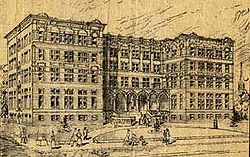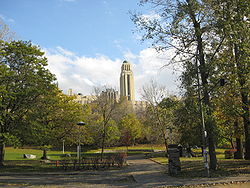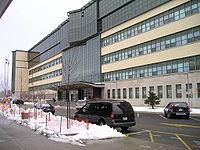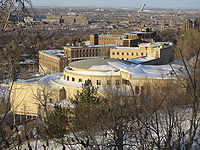历史
Early years
As an institution, the university was first founded when the Laval University (Université Laval) in Quebec City founded a new branch in Montreal in 1878, which became known as the Université de Laval à Montréal. This initially went against the wishes of Montreal's prelate, who advocated an independent university in his city. Certain parts of the institution's educational facilities, such as those of the Séminaire de Québec, had already been established in Montreal as early as 1876. The Vatican granted the university some administrative autonomy in 1889, thus allowing it to choose its own professors and license its own diplomas. However it was not until May 8, 1919 that a papal charter from Pope Benedict XV granted full autonomy to the university. It thus became an independent Catholic university and adopted Université de Montréal as its name. Laval composed by Wilfrid Beaudry was dedicated to the students at Laval University and the University of Montreal. The music for piano was published in Québec by J. Beaudry, circa 1906.
At the time of its creation, less than a hundred students were admitted to the university's three faculties, which at that time were located in Old Montreal. These were the faculty of theology (located at the Grand séminaire de Montréal), the faculty of law (hosted by the Society of Saint-Sulpice) and the faculty of medicine (at the Château Ramezay).
Graduate training based on German-inspired American models of specialized course work and completion of a research thesis was introduced and adopted. Most of Quebec's secondary education establishments employed classic course methods of varying quality. This forced the university to open a preparatory school in 1887 to harmonize the education level of its students. Named the "Faculty of Arts", this school would remain in use until 1972 and was the predecessor of Quebec's current CEGEP system.
Founding by provincial charter
Although a branch of Laval University was planned as Montreal's first French-language university, it was not until February 14, 1920, that the first provincial charter founding the university was passed. The second provincial charter was passed in 1950. The policy of university education initiated in the 1960s (following the Quiet Revolution) was a response to popular pressure and the belief that higher education was a key to social justice and economic productivity for individuals as well as society. The third provincial charter, which was passed in 1967, defined the Université de Montréal as a public institution, dedicated to higher learning and research, in the administration of which students and teachers would have the right to participate.
Campus relocation

Former campus on Saint Denis street.

A view of the present Roger Gaudry building, built in 1943 and designed by Ernest Cormier, on Mount Royal.
From 1876 to 1895, most university classes took place in the Grand séminaire de Montréal. From 1895 to 1942, it was housed in a building on the intersection of the Saint Denis and Sainte Catherine streets in Montreal's downtown Quartier Latin.
Unlike other anglophone universities in Montreal, such as McGill University, the university suffered a lack of funding for two major reasons: the relative poverty of the French Canadian population and the complications ensuing from its remote management from Quebec City. The downtown campus was hit by three different fires between 1919 and 1921, further complicating the university's already precarious finances and forcing it to spend much of its resources on repairing its own infrastructure.
By 1930, enough funds had been accumulated to start the construction of a new campus on Mount Royal, adopting new plans designed by Ernest Cormier. However, the financial crisis of the 1930s virtually suspended all ongoing construction. Many speculated that the university would have to sell off its unfinished building projects in order to ensure its own survival. Not before 1939 did the provincial government directly intervene by injecting public funds. Campus construction subsequently resumed and the mountain campus was officially inaugurated on June 3, 1943. The university's former downtown facilities would later serve Montreal's second francophone university, the Université du Québec à Montréal (UQAM).
Nuclear research
Main article: Montreal Laboratory
In 1943, the university assisted the Western Allies by providing laboratory accommodations on its campus. Scientists there worked to develop a nuclear reactor, notably by conducting various heavy water experiments. The research was part of the larger Manhattan Project, which aimed to develop the first atomic bomb. Scientists here managed to produce the first atomic battery to work outside of the United States. One of the participating Québécois scientists, Pierre Demers, also discovered a series of radioactive elements issued from Neptunium.
Growth and expansion

École Polytechnique as it stands today.
Two distinct schools eventually became affiliated to the university. The first was the École Polytechnique, a school of engineering, which was founded in 1873 and became affiliated in 1887. The second was the École des Hautes Études Commerciales, or HEC, which was founded in 1907 and became part of the university in 1915. The first francophone school of architecture in Canada opened in 1907 at the École Polytechnique.
Between 1920 and 1925, seven new faculties were added to the initial three: Philosophy, Literature, Sciences, Veterinary medicine, Dental surgery, Pharmacy and Social sciences. Notably, the Faculty of Social sciences was founded in 1920 by Édouard Montpetit, the first laic to lead a faculty. He thereafter fulfilled the role of secretary-general until 1950.
In 1965, the appointment of the university's first secular rector, Roger Gaudry, paved the way for modernization. The university established the first adult education degree program offered by a French Canadian university in 1968.
An important event that marked the university's history was the École Polytechnique massacre. On December 6, 1989, a gunman armed with an automatic rifle entered the École Polytechnique building, killing 14 people, all of whom were women, before taking his own life.
Since 2002, the university has embarked on its largest construction projects since the late 1960s, with five new modern buildings planned for advanced research in pharmacology, engineering, aerospace, cancer studies and biotechnology.
校园
The university's main campus is located on the northern slope of Mount Royal in the Outremont and Côte-des-Neiges boroughs. Its landmark Roger Gaudry pavilion, which was designed by the noted architect Ernest Cormier, can be seen from around the campus and is known for its imposing tower. It is built mainly in the Art Deco style, with some elements of International style.
The campus is served by the Côte-des-Neiges, Université-de-Montréal, and Édouard-Montpetit metro stations.
Apart from its main Mount Royal campus, the university also maintains four regional facilities in Lanaudière, Laval, Longueuil and Quebec. The campus in Laval, just north of Montreal, was opened in 2006. It is Laval's first university campus, and is located in the area near the Montmorency metro station. In October 2009, the university announced an expansion to its Laval satellite campus with the commissioning of its six-storey Cité du Savoir complex. In order to solve the problem of lack of space on its main campus, the university is also planning to open a new campus in Outremont.
The Centre hospitalier de l'Université de Montréal (CHUM) and the Centre hospitalier universitaire Sainte-Justine are the two teaching hospital networks of the Université de Montréal's Faculty of Medicine, although the latter is also affiliated with other medical institutions such as the Institut universitaire de gériatrie de Montréal.
Student life
There are various student groups, clubs and associations on the university's campus, the largest of them being the FAÉCUM, a federation of students' unions.
The campus offers various student-run newspapers, the largest being Quartier Libre, a member of the Canadian University Press (CUP). The campus also has its own student-run radio station, CISM-FM.
University of Montreal officially recognized one fraternity on the campus: Sigma Thêta Pi .
学术
Faculties

Université de Montréal's Faculty of Music
- Faculty of Landscape Architecture, Design and Urban Planning
- Faculty of Arts and Sciences
- Faculty of Law
- Faculty of Continuing Education
- Faculty of Graduate Studies
- Faculty of Medicine
- Faculty of Dentistry
- Faculty of Veterinary Medicine
- Faculty of Music
- Faculty of Pharmacy
- Faculty of Education
- Faculty of Nursing
- Faculty of Theology and Religious Studies
- Department of Kinesiology
- School of Optometry
Affiliated schools
- HEC Montréal (School of Management)
- École Polytechnique (School of Engineering)
Research centres
Several research-dedicated organizations can also be found on the university's campus, such as the Centre for International Studies.
Rankings
|
|
This section does not cite any references or sources.
Please help improve this article by adding citations to reliable sources. Unsourced material may be challenged and removed. (October 2009) |
| University rankings |
| ARWU World |
101-151 |
| ARWU N. America |
60-77 |
| ARWU Life Sciences |
76-100 |
| ARWU Social Sciences |
76-100 |
| THE-QS World |
107 |
| THE-QS Arts |
81 |
| THE-QS Life Sciences/Biomed |
83 |
| THE-QS Natural Sciences |
128 |
| THE-QS Social Sciences |
86 |
| THE-QS Engineering/Tech. |
117 |
| Canadian rankings |
| Maclean's Medical/Doctoral |
13 |
|
v • d • e
|
National
Université de Montréal was ranked 13th (among 15 universities) in Canada in the category "Medical Doctoral" in the Maclean's 18th Annual Ranking issue, which ranks Canadian universities only. The Medical Doctoral category ranks universities that have a broad range of Ph.D. programs and research, as well as medical schools. Furthermore, since Maclean's began ranking Canadian law schools in 2007, it has placed Universite de Montréal's law school first overall civil law school for the second year in a row. Meanwhile, the Gourman Ranking of Canadian Universities ranked Universite de Montréal 12th (over 60 universities in Canada) in its 1998 report on undergraduate programs.
International
International rankings have been more generous than national ones when ranking Université de Montréal. In 2009, the Times Higher Education ranked the University 107th in the world. In Shanghai Jiao Tong University's Academic Ranking of World Universities 2008, Université de Montréal ranked 5th to 6th in Canada, 59th to 77th in the Americas, and 101st to 151th in the world. The Global University Ranking 2009 placed Université de Montréal 72-73rd in the world and 3rd in Canada. The Newsweek Top 100 Global Universities ranking does not include Universite de Montréal as one of the top 100 universities in the world. In 2009, Forbes ranked Université de Montréal's business school, HEC Montréal, 10th in the world among non-U.S. universities for its one-year MBA program. Université de Montréal ranked 1st in Canada in the one-year MBA program category.
体育运动
The university is represented in Canadian Interuniversity Sport by the Carabins. The Carabins, whose origins date back to 1922, currently rank among the top 10 university teams in Canada. The organization has about 300 student athletes organized in 15 different teams and 8 disciplines: badminton, football, golf, swimming, alpine skiing, soccer, tennis and volleyball. Following the establishment of a Club of Governors in June 2002, the Carabins are now partly financed through private funds. Initially lead by Formula One Grand Prix president Normand Legault, the Club is composed of various business personalities and is currently headed by Rona CEO Robert Dutton.
On January 31, 2008, the Carabins announced the creation of its first female hockey team, which after training and preparation should officially start competing by fall 2009.
[edit] Faculty and alumni
Main article: List of Université de Montréal people
Noted faculty
- Stéphane Dion, former professor of political science, leader of the Liberal Party of Canada (2006–2008).
- Hubert Lacroix, associate professor with Faculty of Law
- James R. Taylor, professor emeritus at the department of communication.
- Michel Seymour, professor of philosophy.
- Dale C. Thomson, DFC, professor and departmental director. Also professor and Vice-Principal of McGill University and a professor of international relations and Director of the Center of Canadian Studies at Johns Hopkins University's School of Advanced International Studies in Washington, D.C. and the author of several important historical works.
- Jean-Daniel Lafond, former professor and current Viceregal consort of Canada.
Noted alumni
An Order of Merit is appointed to particularly successful alumni on annual basis.
- Modjtaba Sadria, Philosopher, Honorary Professor of Centre for Ethics in Medicine and Society in Monash University, Australia
- Ishfaq Ahmad, nuclear physicist and pioneer of Pakistani nuclear program
- Stéphanie Allard-Gomez, diplomat
- Louise Arbour, Supreme Court of Canada Justice (1999–2004), UN High Commissioner for Human Rights (2004–2008)
- Denys Arcand, filmmaker
- Michel Bastarache, Supreme Court of Canada Justice (1997–2008)
- Josephat T. Benoit, nine-term Mayor of Manchester, New Hampshire
- Jean-Jacques Bertrand, Premier of Quebec (1968–1970)
- André Boisclair, leader of the Parti Québécois (2005–2007)
- Robert Bourassa, Premier of Quebec (1970–1976, 1985–1994)
- Louis R. Chênevert, CEO of United Technologies Corporation
- Marie Deschamps, Supreme Court of Canada Justice (2002–present)
- Maurice Duplessis, Premier of Quebec (1936–1939, 1944–1959)
- Dédé Fortin, singer
- Armand Frappier, physician and microbiologist
- Lomer Gouin, Premier of Quebec (1905–1920)
- Roger Guillemin, Nobel Prize Laureate (Medicine, 1977)
- Abderraouf Jdey, alleged terrorist
- Michaëlle Jean, journalist, Governor General of Canada
- Daniel Johnson, Jr., Premier of Quebec (1994)
- Daniel Johnson, Sr., Premier of Quebec (1966–1968)
- Pierre-Marc Johnson, Premier of Quebec (1985)
- Antonio Lamer, Supreme Court of Canada Chief Justice (1990–2000)
- Blanche Lamontagne-Beauregard, first published female poet in Quebec
- Bernard Landry, Premier of Quebec (2001–2003)
- Georges-Émile Lapalme, leader of the Quebec Liberal Party (1950–1958)
- Elsie Lefebvre, PM for the Laurier-Dorion county
- Isabelle Mercier, professional poker player
- Anne Montminy, competitive diver, lawyer
- Jacques Parizeau, Premier of Quebec (1994–1996)
- Pierre-Karl Péladeau, CEO of Quebecor
- Hubert Reeves, astrophysicist
- Paul Sauvé, Premier of Quebec (1959–1960)
- Lucille Teasdale-Corti, surgeon and international humanitarian aid worker (1929–1996)
- Pierre Eliott Trudeau, Prime Minister of Canada (1968–1979, 1980–1984)
更多
 |
Montreal portal |
 |
University portal |
- Canal Savoir
- Education in Montreal
- Fédération des associations étudiantes du campus de l'Université de Montréal
- List of Quebec universities
- List of universities with accredited dietetic programs
- Higher education in Quebec
- Canadian Interuniversity Sport
- Canadian government scientific research organizations
- Canadian university scientific research organizations
- Canadian industrial research and development organizations
- Centre for International Studies
参考文献
- ^ Valid as of June 30, 2008. See Annual Report (English), "Market Value of Endowment Fund", p. 21
- ^ Université de Montréal official statistics (French)
- ^ The name is the same in both English and French. "2007 Annual Report (English). Université de Montréal Accessed October 20, 2008.
- ^ General overview of Université de Montréal
- ^ Research Infosource Inc. - Canada's Top 50 Research Universities 2008
- ^ 2007 Annual Report (English), "Research Income by University", p. 27
- ^ Université de Montréal - Fêtes du 125 - 125 ans d'histoire (1878-2003) (French)
- ^ The Canadian Encyclopedia - University
- ^ The Canadian Encyclopedia - Université de Montréal
- ^ Université de Montréal - Fêtes du 125 - 125 ans d'histoire (1878-2003) (French)
- ^ Laval http://amicus.collectionscanada.gc.ca/ourl/c.php?id=16182129&l=eng&s=amicus
- ^ Université de Montréal - English - Brief History
- ^ Université de Montréal - Information générale (French)
- ^ Université de Montréal - Fêtes du 125 - 125 ans d'histoire (1878-2003) (French)
- ^ Université de Montréal - Fêtes du 125 - 125 ans d'histoire (1878-2003) (French)
- ^ Université de Montréal - Fêtes du 125 - 125 ans d'histoire (1878-2003) (French)
- ^ Université de Montréal - Fêtes du 125 - 125 ans d'histoire (1878-2003) (French)
- ^ Université de Montréal - Fêtes du 125 - 125 ans d'histoire (1878-2003) (French)
- ^ Université de Montréal - Fêtes du 125 - 125 ans d'histoire (1878-2003) (French)
- ^ The Canadian Encyclopedia - Architectural Education
- ^ Université de Montréal - Fêtes du 125 - 125 ans d'histoire (1878-2003) (French)
- ^ Université de Montréal - Bureau de l'enseignement régional (French)
- ^ Croteau, Martin (October 14, 2009). "Nouveau campus de l'UdM à Laval" (in French). La Presse (Montreal). http://www.cyberpresse.ca/actualites/quebec-canada/education/200910/14/01-911374-nouveau-campus-de-ludm-a-laval.php. Retrieved 2009-10-16.
- ^ Université de Montréal - Outremont facility project page (French)
- ^ University of Montreal Student Group
- ^ "Academic Ranking of World Universities". Institute of Higher Education, Shanghai Jiao Tong University. 2008. http://www.arwu.org/rank2008/EN2008.htm. Retrieved 2009-01-04.
- ^ "Top 100 North & Latin American Universities". Institute of Higher Education, Shanghai Jiao Tong University. 2008. http://www.arwu.org/rank2008/ARWU2008_TopAmer(EN).htm. Retrieved 2009-01-04.
- ^ "Top 100 world universities in Life and Agriculture Sciences". Institute of Higher Education, Shanghai Jiao Tong University. 2008. http://ed.sjtu.edu.cn/ARWU-FIELD2008/LIFE2008.htm. Retrieved 2008-02-19.
- ^ "Top 100 world universities in Social Sciences". Institute of Higher Education, Shanghai Jiao Tong University. 2008. http://ed.sjtu.edu.cn/ARWU-FIELD2008/SOC2008.htm. Retrieved 2008-02-19.
- ^ "World University Rankings". Times Higher Education-Quacquarelli Symonds. 2008. http://www.timeshighereducation.co.uk/hybrid.asp?typeCode=243&pubCode=1&navcode=137. Retrieved 2008-12-31.
- ^ "THE-QS Top Universities Rankings: Arts and Humanities". Times Higher Education-Quacquarelli Symonds. 2008. http://www.topuniversities.com/worlduniversityrankings/results/2008/subject_rankings/arts_humanities/. Retrieved 2008-02-25.
- ^ "THE-QS Top Universities Rankings: Life Sciences and Biomedicine". Times Higher Education-Quacquarelli Symonds. 2008. http://www.topuniversities.com/worlduniversityrankings/results/2008/subject_rankings/life_sciences_biomedicine/. Retrieved 2008-02-25.
- ^ "THE-QS Top Universities Rankings: Natural Sciences". Times Higher Education-Quacquarelli Symonds. 2008. http://www.topuniversities.com/worlduniversityrankings/results/2008/subject_rankings/natural_sciences/. Retrieved 2008-02-25.
- ^ "THE-QS Top Universities Rankings: Social Sciences". Times Higher Education-Quacquarelli Symonds. 2008. http://www.topuniversities.com/worlduniversityrankings/results/2008/subject_rankings/social_sciences/. Retrieved 2008-02-25.
- ^ "THE-QS Top Universities Rankings: Technology". Times Higher Education-Quacquarelli Symonds. 2008. http://www.topuniversities.com/worlduniversityrankings/results/2008/subject_rankings/technology/. Retrieved 2008-02-25.
- ^ "Medical Doctoral Ranking". Maclean's. 2008. http://oncampus.macleans.ca/education/wp-content/uploads/2008/11/med.pdf. Retrieved 2009-01-04.
- ^ Times Higher Education, "QS World University Rankings: Top 200 World Universities". 01-10-2009. (Retrieved 13-11-2009)
- ^ http://www.globaluniversitiesranking.org/images/banners/top-100(eng).pdf
- ^ Université de Montréal - Carabins - Historique (French)
- ^ Université de Montréal - Gala de l'Ordre du Mérite (French)
扩展阅读
- Bizier, Hélène-Andrée. 1993. L'Université de Montréal: la quête du savoir. Montréal: Libre expression. 311 pp. ISBN 2891115228 [1]
External links
- Université de Montréal
- Pictures and information on Université de Montréal buildings



